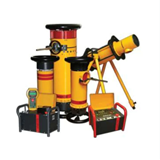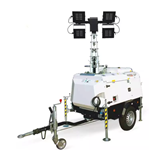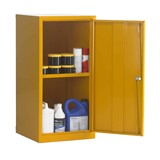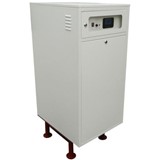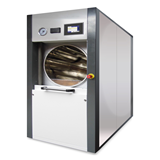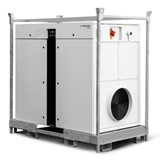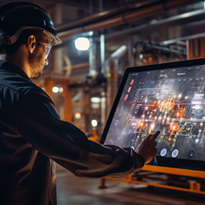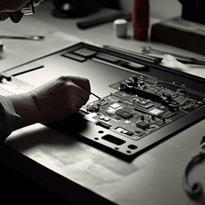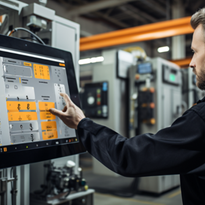In the ever-evolving landscape of industrial technology, industrial touch screen monitors have emerged as crucial tools for enhancing efficiency and productivity. These intuitive interfaces offer seamless interaction and real-time data access, enabling operators to control complex machinery and processes with ease. However, in demanding industrial environments, where factors like harsh weather conditions, high levels of shock and vibration, and strict safety regulations come into play, ensuring the reliability and safety of industrial touch screen monitors becomes paramount.
This comprehensive guide delves into the key aspects that industries must consider to ensure the optimal performance and safety of industrial touch screen monitors in their operations.
From selecting the appropriate Ingress Protection (IP) rating to complying with industry standards, mitigating screen glare, and implementing emergency shutdown protocols, we explore each facet exhaustively. Additionally, personnel training's significance is emphasized, as knowledgeable operators are an essential element in safe and efficient touch screen monitor usage.
1. Selecting the Appropriate IP Rating: Protecting Against Environmental Factors
In industrial environments, industrial touch screen monitors are exposed to a myriad of environmental factors that can compromise their functionality and durability. One of the primary considerations in safeguarding these devices against such hazards is the Ingress Protection (IP) rating. The IP rating is a two-digit code that classifies the level of protection provided by an enclosure against solids and liquids. The first digit represents protection against solids, while the second digit denotes protection against liquids.
Key Points to consider are:
- Understanding the IP Rating System: The IP rating system follows a standardized format where the first digit ranges from 0 to 6, indicating protection against solids, and the second digit ranges from 0 to 9K, indicating protection against liquids. For instance, a device rated IP65 ensures complete protection against dust (6) and is resistant to low-pressure water jets from any direction (5).
- Suitability for the Environment: To select the appropriate IP rating for industrial touch screen monitors, industries must assess the specific environmental challenges they face. If the monitors are installed in areas exposed to high levels of dust, debris, or contaminants, a higher IP rating (e.g., IP66 or higher) becomes necessary to ensure a dust-tight seal.
- Protection Against Water: Industries with industrial touch screen monitors situated in locations where exposure to water or liquid is likely (e.g., outdoor installations or wet processing facilities) should opt for monitors with a higher second digit in the IP rating. Monitors rated IPX6 or above offer protection against powerful water jets and can withstand intense cleaning procedures.
- Outdoor Applications: For outdoor applications, such as rugged industries or transportation systems, industrial touch screen monitors with an IP rating of IP67 or IP68 are ideal. These monitors can endure temporary immersion in water and provide optimal protection against dust and moisture.
- Temperature and Humidity Considerations: Apart from dust and water protection, industries should also factor in temperature and humidity ratings of industrial touch screen monitors. Extreme temperatures or humidity levels can affect the monitor's performance. Monitors equipped with a wide operating temperature range (-20°C to 60°C, for instance) are better suited for industrial environments.
- Explosion-Proof Ratings: In hazardous environments, where flammable materials are present, explosion-proof industrial touch screen monitors with an appropriate IP rating (e.g., IP65/66 for Zone 1 or Zone 2 areas) should be considered to prevent potential disasters.
2. Shock and Vibration Resistance: Withstanding Industrial Conditions
Industrial environments are synonymous with mechanical impacts, constant vibrations, and shocks caused by heavy machinery, equipment, and vehicles. These dynamic conditions can significantly impact industrial touch screen monitors' performance and longevity. Thus, shock and vibration resistance are vital attributes to ensure the reliable operation of industrial touch screen monitors in industrial settings.
- Rugged Construction and Materials: To withstand shocks and vibrations, industrial touch screen monitors must feature robust construction and be built with durable materials. Sturdy metal enclosures and ruggedized screens can absorb and dissipate shock forces, minimizing potential damage.
- Vibration Damping Mechanisms: Advanced industrial touch screen monitors may incorporate vibration damping mechanisms, such as resilient mounting solutions or shock-absorbent coatings, to mitigate the effects of vibrations.
- Testing and Certifications: industrial touch screen monitors designed for industrial use should undergo rigorous testing for shock and vibration resistance. Compliance with industry-specific standards, such as MIL-STD-810G, ensures monitors can endure various shock and vibration scenarios.
- Ingress Protection and Shock Resistance Synergy: The combination of an appropriate IP rating and shock resistance is critical. A robust IP-rated enclosure, along with shock-resistant features, enhances the overall durability of the monitor, making it more resilient to harsh industrial conditions.
- Safeguarding Internal Components: Internal components, such as circuit boards and connectors, should be adequately protected against shocks and vibrations. Secure mounting and strain relief mechanisms prevent disconnections or damage during sudden impacts.
3. Compliance with Industry Standards and Regulations: Meeting Safety Requirements
In the context of industrial industrial touch screen monitors, adherence to industry-specific standards and regulations is non-negotiable. Complying with these requirements not only ensures safe and reliable operation but also fosters confidence among stakeholders in the facility's overall safety management system.
- Understanding Industry-Specific Standards: Different industries have their own set of standards and regulations pertaining to industrial touch screen monitors' safety and performance. For instance, industries with hazardous locations may follow the ATEX directive, while the medical sector may comply with IEC 60601-1 for medical electrical equipment.
- Electromagnetic Compatibility (EMC): Industrial environments are rife with electromagnetic interference (EMI) from various sources. Ensuring industrial touch screen monitors meet EMC standards (e.g., IEC 61000 series) prevents interference issues and ensures proper functionality.
- Certifications and Labels: Look for relevant certifications and labels on industrial touch screen monitors, such as CE marking, UL listing, or IP ratings. These symbols indicate that the product has undergone testing and meets specific safety and quality standards.
- Ergonomics and Safety: Apart from industry-specific regulations, consider ergonomic guidelines, such as ISO 9241, to ensure the monitor's design minimizes operator fatigue and discomfort during extended use.
- Documentation and Compliance Records: Industries should maintain comprehensive documentation of industrial touch screen monitors' compliance with standards and regulations. These records are essential during audits or inspections to demonstrate due diligence in safety management.
4. Reducing Screen Glare and Reflections for Optimal Visibility
Clear visibility of industrial touch screen monitors is vital in industrial environments, where lighting conditions can vary significantly. Excessive glare and reflections on the monitor can hinder operators' ability to read and interact with the display accurately, leading to potential errors and safety risks.
- Anti-Glare and Anti-Reflective Coatings: industrial touch screen monitors designed for industrial use often feature anti-glare and anti-reflective coatings. These coatings reduce the amount of ambient light reflected off the screen, improving readability under bright lighting conditions.
- Adjustable Brightness and Contrast: Monitors equipped with adjustable brightness and contrast settings allow operators to optimize the display according to the surrounding lighting conditions, ensuring a comfortable viewing experience.
- Optical Bonding: Optical bonding is a technique where a layer of optical-grade adhesive is applied between the touch screen and the display to eliminate air gaps. This process reduces reflections and improves visibility in bright environments.
- Sunlight Readability: Industries operating outdoors or in areas with direct sunlight should opt for industrial touch screen monitors with sunlight-readable displays. These displays employ high-brightness panels and anti-reflective coatings to combat glare effectively.
- Positioning and Tilting: Proper positioning and tilting of industrial touch screen monitors can help minimize glare and reflections. Mounting the monitors at an appropriate angle and avoiding direct light sources can enhance visibility.
- Physical Shading and Enclosures: Some industrial applications may benefit from using physical shading or enclosures to protect the touch screen monitor from direct light sources, reducing glare and reflections.
5. Implementing Emergency Shutdown Protocols: Enhancing Workplace Safety
Industrial processes and machinery can pose potential hazards to operators, and industrial touch screen monitors often serve as critical interfaces for controlling these systems. In emergency situations, swift and effective shutdown protocols are essential to ensure the safety of personnel and prevent further damage.
- Redundant Shutdown Controls: industrial touch screen monitors should be equipped with redundant shutdown controls, allowing operators to initiate an emergency stop from multiple access points in the facility.
- E-Stop Buttons: Integrating physical emergency stop (E-stop) buttons near industrial touch screen monitors provides an immediate means of halting operations in case of emergencies, even if the monitor becomes unresponsive.
- Visual and Auditory Alarms: Monitors can be programmed to display visual alarms, such as flashing warning messages, and sound audible alarms to alert operators of critical situations that require immediate attention.
- Safety Interlocks: Safety interlock systems can be implemented, wherein certain conditions must be met before the touch screen monitor allows specific actions, preventing accidental or unauthorized operations.
- Emergency Shutdown Training: Personnel should undergo comprehensive training on emergency shutdown procedures, including scenarios where industrial touch screen monitors may malfunction or become inaccessible.
- Testing and Maintenance: Regular testing and maintenance of emergency shutdown systems, including industrial touch screen monitors, are crucial to ensure their reliability during critical situations.
6. Personnel Training for Safe and Efficient Touch Screen Monitor Usage
While advanced industrial touch screen monitors can enhance efficiency and safety, their effectiveness heavily relies on the competence of the operators. Proper training and education of personnel regarding touch screen monitor usage, safety protocols, and troubleshooting are vital for optimizing performance and minimizing potential risks.
- Basic Functionality Training: Personnel should receive fundamental training on touch screen monitor functionality, including navigation, data input, and menu access. A solid understanding of the monitor's features is crucial for smooth operations.
- Safety Procedures: Comprehensive training on safety procedures, emergency shutdown protocols, and potential hazards associated with touch screen monitor usage should be provided to all operators.
- Troubleshooting Skills: Operators should be equipped with troubleshooting skills to identify and resolve common touch screen monitor issues quickly. This minimizes downtime and reduces the need for external technical support.
- Proper Cleaning and Maintenance: Training personnel on proper cleaning and maintenance practices ensures the industrial touch screen monitors remain in optimal condition, extending their lifespan and preventing potential issues.
- Understanding Error Messages: Operators should be able to interpret and respond appropriately to error messages displayed on industrial touch screen monitors. Prompt and correct actions can prevent the escalation of issues.
- Familiarity with Industry-Specific Applications: Industries often use specialized software and applications on industrial touch screen monitors. Proper training on these applications ensures efficient utilization of the monitor's capabilities.
Conclusion
By meticulously selecting industrial touch screen monitors with the appropriate IP rating, industries can safeguard these devices against the myriad of environmental challenges they may encounter. A robust IP rating, coupled with shock and vibration resistance, ensures that industrial touch screen monitors can endure the harsh conditions inherent in industrial settings, thereby prolonging their lifespan and reducing costly downtimes.
By prioritizing the training of personnel on touch screen monitor functionality, safety procedures, troubleshooting skills, and industry-specific applications, industries can cultivate a workforce that is not only adept at using the technology but also vigilant in identifying and responding to potential issues.

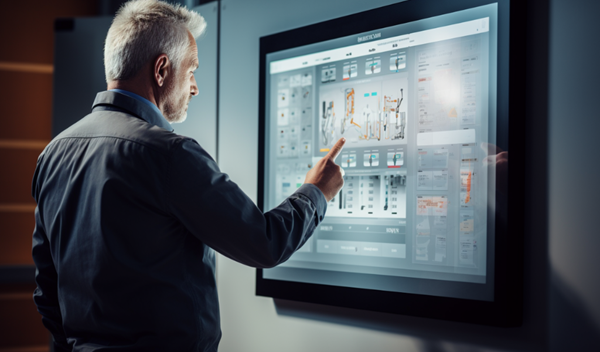

-160x160-state_article-rel-cat.png)




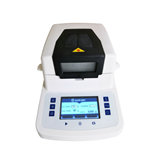
-160x160-state_article-rel-cat.jpg)


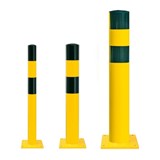
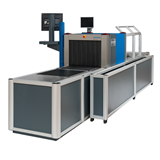
-160x160-state_article-rel-cat.png)
